Navratri is a festival dedicated to the worship of the Hindu deity ‘Durga’. The word Navaratri means ‘nine nights’ in Sanskrit, nava meaning nine and ratri meaning nights. During these nine nights and ten days, nine forms of Shakti/Devi are worshiped.
Navratri is celebrated in the beginning of spring and the beginning of autumn which are considered to be important junctions of climatic and solar influences. These two periods are taken as sacred opportunities for the worship of the Divine Mother Durga. The dates of the festival are determined according to the lunar calendar.
The Navratri abstinence or Vrat is observed from the first day to the ninth day. Most people confine themselves to fruit during the nine days/nights. Other devotees take a single meal during the day/night, and non-vegetarian food is avoided. Also, the consumption of onion and garlic is avoided for the entire duration of Navaratri. ~ Wikipedia

Ever since my childhood, I’ve looked forward to the festival of Navratri. As a child I was not aware of the significance of the festival. It was the delicious food prepared by my mother during the festival that was the main appeal. Till date I don’t know why its called fasting. Most dishes are deep fried. Other dishes which include fruit, sabudana and vegetables are tasteful and full of flavour. The dishes I prepare today are mostly what my mother cooks. A few dishes I have learnt from neighbours and the extended family.
In my family we eat the ‘falhar’ or fasting food for the first seven days. On ‘Ahstmi’ or the eighth day, we do the pooja and have Sooji Halwa, Kale Chane and Puris for ‘parsad’.
Here I share some of the recipes that I cook for the Navratri fast at home. My mother offers the first thali/plate as ‘bhog’ or as food to the Gods. The one thing that I remember most is that she would always place one bowl of drinking water with leaves of the Tulsi plant in it. Just as we drink water with our food, so do the Gods and that is what I do even today. I have posted enough dishes to see any one through the seven days of Navratri fasting.
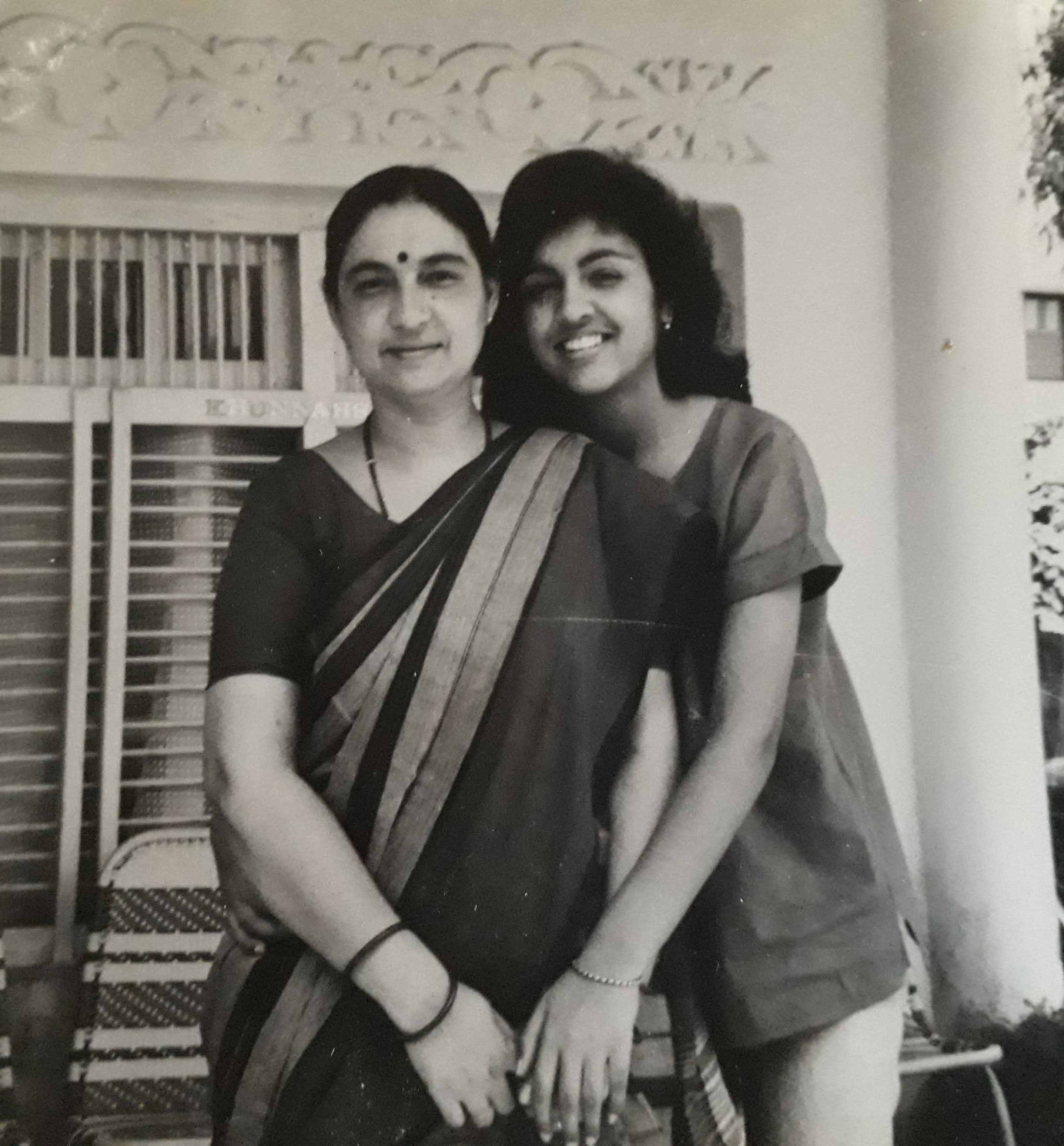

The main ingredients used during this religious fasting are buckwheat flour, water-chestnut flour, potatoes, arbi, cucumbers, sweet potatoes, yogurt, fruits, fruit juices and milk. Spices used are bare minimum of carom seeds, red chilli powder and dried mango powder. It’s pure vegetarian food where meat, onion, garlic and eggs are avoided.
Kuttu or Buckwheat is not a cereal grain but actually a fruit seed, therefore its flour is eaten during religious fasting in India.
Singhara or Water Chestnut is a fruit therefore eaten during religious fasting in India. It can be eaten raw, boiled or as flour, after drying and grinding.
Fox Nut, also known as Makhana in Hindi is a flowering plant classified in the water lily family. The plant produces starchy white seeds that are edible and may be eaten raw or cooked. Makhana is an auspicious ingredient in offerings to the Goddesses during festivals and is used to show reverence.
In the Navratri diet Samak Chawal is a good replacement for rice eaters as it is not a cereal but a fruit. In fact, it can be eaten in every religious fast. It provides the nourishment and energy similar to rice.
Tapioca Sago is generally known as sabudana in Hindi. Sago is a produce, prepared from the milk of Tapioca Root. As Sabudana is mainly starch which contains carbohydrates, it is great for a quick boost of energy, and is often served in India for breaking fasts during religious festivals. Sabudana can be cooked in either savoury or sweet dishes.
Arbi or Colocasia esculenta is thought to be native to Southern India and Southeast Asia. It is a perennial, tropical plant primarily grown as a root vegetable for its edible starchy corm. Arbi is one of the finest source dietary fibres. Together with slow digesting complex carbohydrates, moderate amounts of fibre in the food help gradual rise in blood sugar levels and for this reason it is a good vegetable to have during fasting.

Fruit Chaat
During religious fasting in India, one abstains from regular meals. Fruits are popularly eaten either by themselves, as juice or fruit chaats (cut fruits spiced with lemon juice, salt, red chilli powder, sugar). Local and seasonal fruits like Papaya, Apples, Pears, Bananas, Pomegranate are eaten during the Navratri fasting.
To make a fruit chaat, you need to dice your fruits, spice it up with salt and chilli powder and give it a sweet and sour flavour by adding sugar and lemon juice.


Fruit Chaat
Spicy Fruit Medley
Ingredients ~
250 gms combination of fruits of your choice
100 gms cucumber
50 gms boiled potatoes
1 lemon, juice
1/2 tsp salt
2 tsp powdered sugar
chilli powder, optional
Method ~
1. Peel and dice all the fruits, cucumber and potatoes evenly.
2. Add the salt, sugar, lemon juice and chilli powder if using, to the diced fruits. Mix well. Adjust the seasoning to your taste.
Note ~ Add the sugar and salt just before eating. If added too early, the fruits leave their juices and soften up. If you like the chaat to be syrupy then by all means add the sugar and salt an hour in advance.
Imli Chutney with Fruits
Tamarind Chutney with Fruits
Imli chutney is a sweet and sour sauce made from tamarind pulp boiled with sugar or jaggery and spiced with salt, red chilli powder. This chutney is used in most Indian street food dishes to give a sweet and sour tangy taste.
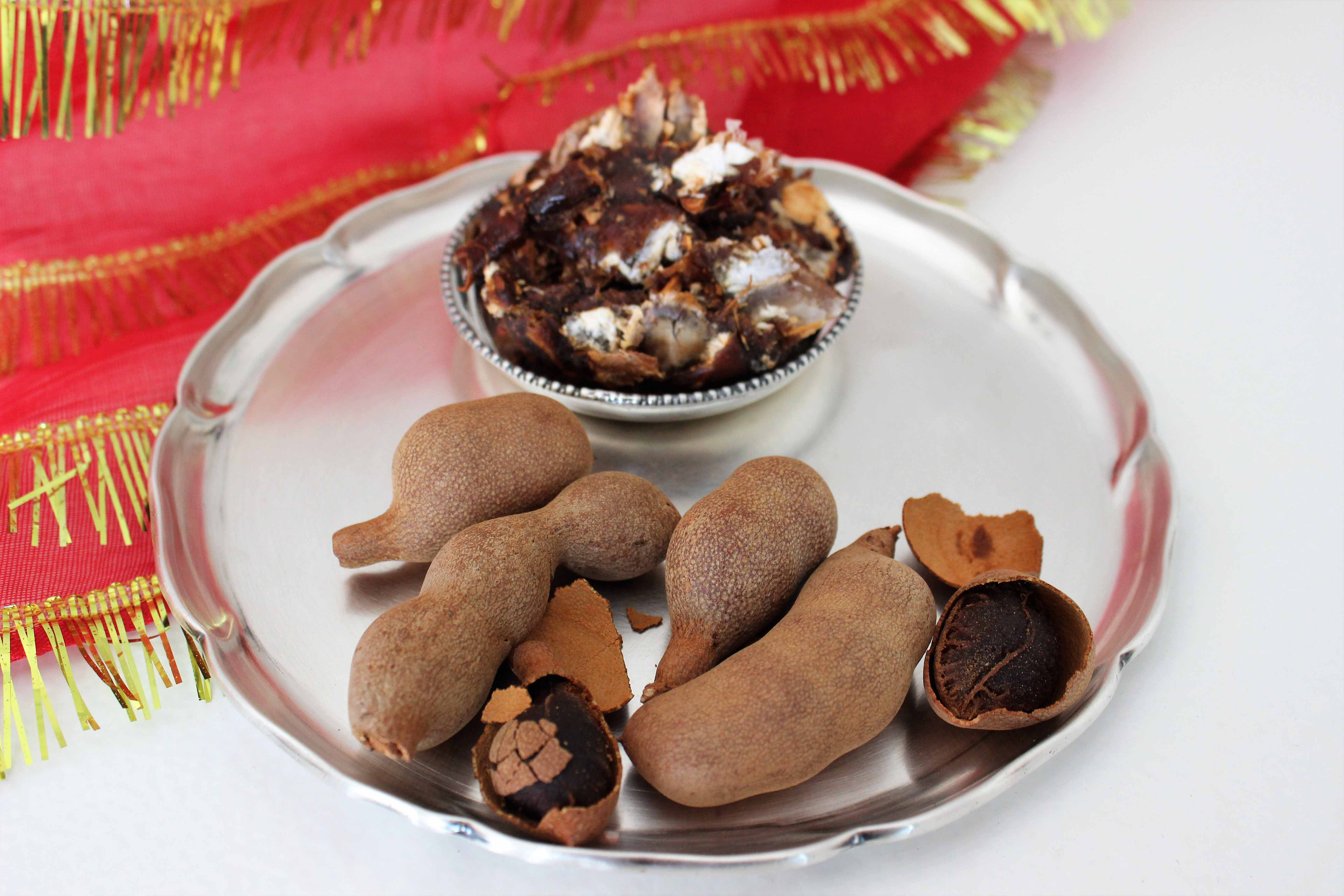
Tamarind or Tamarindus indica is indigenous to tropical Africa but has been cultivated for so long on the Indian subcontinent that it is also considered to be indigenous to India. Today, India is the largest producer of tamarind and its pulp is made into a variety of products.
Tamarind is one of the most sought-after ingredients in Indian cooking and most regional cuisines use it in a variety of ways. It is an important ingredient in chutneys, curries and sauces. It is also used to make sweet and sour confectionery, loved by most Indians, especially in the villages.
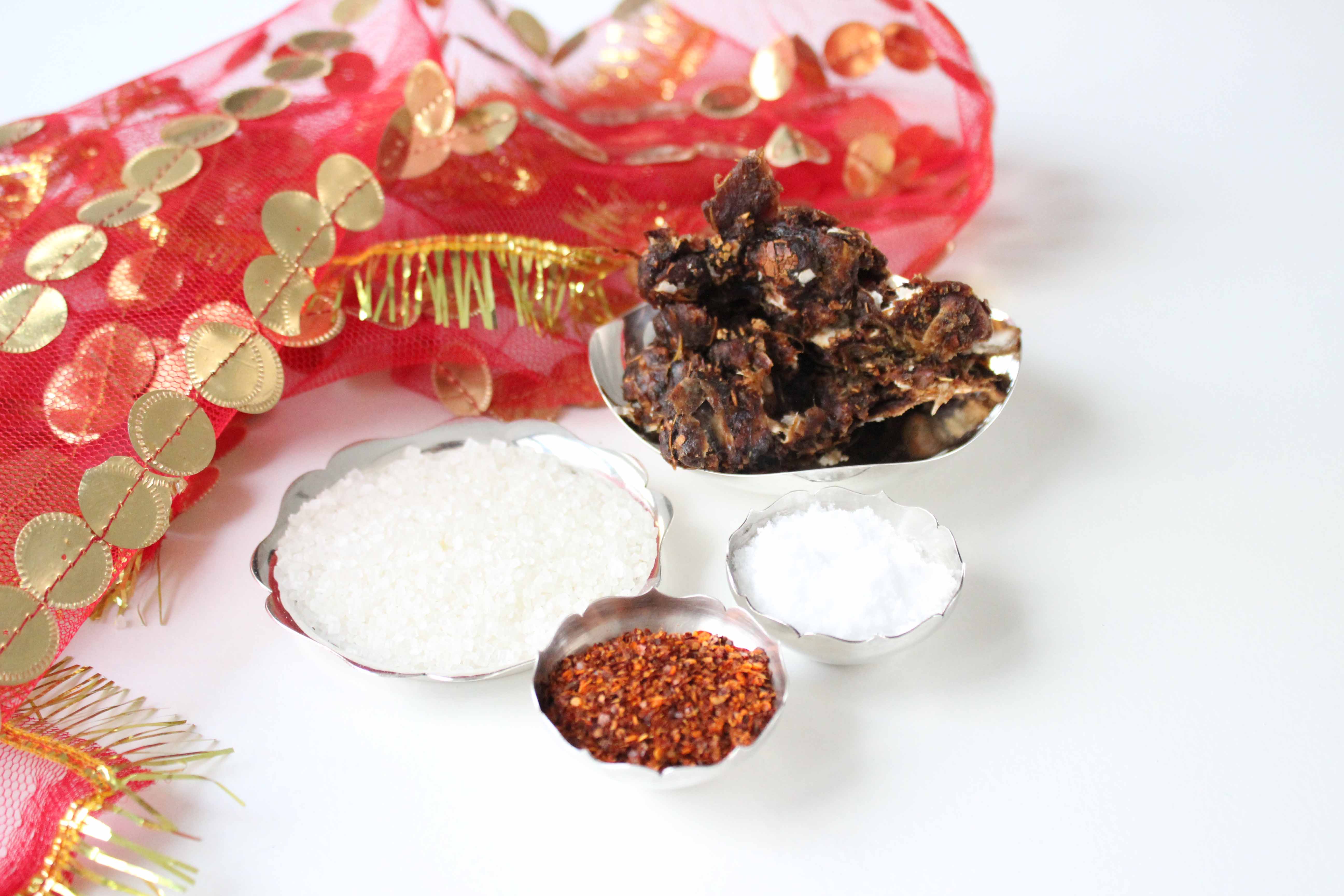

To make Imli Chutney, first you need to wash the tamarind pulp in clean water so as to remove all the dirt and dust, as in India it is dried naturally in the sun on open mats. It is then soaked in drinking water, covered, for upto four hours or even overnight so as to let the dried tamarind pulp rehydrate and become soft. The soaked pulp is then mashed by hand in the soaking water itself and the liquid is strained through a fine mesh strainer collecting the liquid and all the smooth pulp that passes through the mesh. The strained liquid, along with the sugar is boiled till the mixture coats the spoon. Its best to keep it to the consistency of a thin sauce as it thickens on cooling. Care must be taken to use non-reactive vessels as tamarind is a sour agent. Once off the stove the salt and chilli powder are added.
The soaking time of the tamarind should be taken into account. Best to soak it overnight if cooking in the morning or through the day if cooking it at night. Even if you can’t cook it once you’ve soaked the tamarind, just strain the pulp and keep the strained mixture in the refrigerator. It keeps well for 2-3 days without cooking.
The prepared Imli Chutney can be cooled and stored in a jar in the refrigerator for a long time. Mine has lasted for a year, that’s why I always make a large batch. For the purpose of the fast, we add some fruits like banana and pomegranate seeds to add flavour and texture.
Imli Chutney
Tamarind Chutney
Ingredients ~
250 gms dried tamarind, without the hard cover shell
450 gms sugar
1 tsp salt
1/2 tsp red chilli powder
Preparation ~
1. Wash the tamarind pulp in clean water so as to remove all the dirt and dust.
2. Soak the tamarind in drinking water, just enough to cover it, for upto four hours or even overnight.
Method ~
1. Mash the soaked tamarind pulp by hand in the soaking water itself.
2. Strain the liquid through a fine mesh strainer collecting the liquid and all the smooth pulp collected on the underside of the mesh.
3. In a non-reactive vessel, boil the strained liquid, along with the sugar till semi thick or till the liquid falls in a continuous stream from the spoon when lifted. It becomes thicker on cooling. More sugar can be added to taste as the tamarind pulp will differ in sourness from place to place.
4. Once off the stove, add the salt and the red chilli powder to taste.
5. The Imli Chutney should be sweet and sour in taste with a hint of saltiness and chilli.
6. Once cooled, store the chutney in a clean bottle in the refrigerator. It will stay for many months without spoiling.
~If it gets too thick in the refrigerator, add a little drinking water to thin it, to the amount you want to use at a time.
Imli Chutney with Fruits
Tamarind Chutney with Fruits
1. Chop and peel fruits of choice.
2. Add to the amount of Imli chutney using.
3. Use this on the same day. Cannot store with fruits as the fruits will get rancid over time.
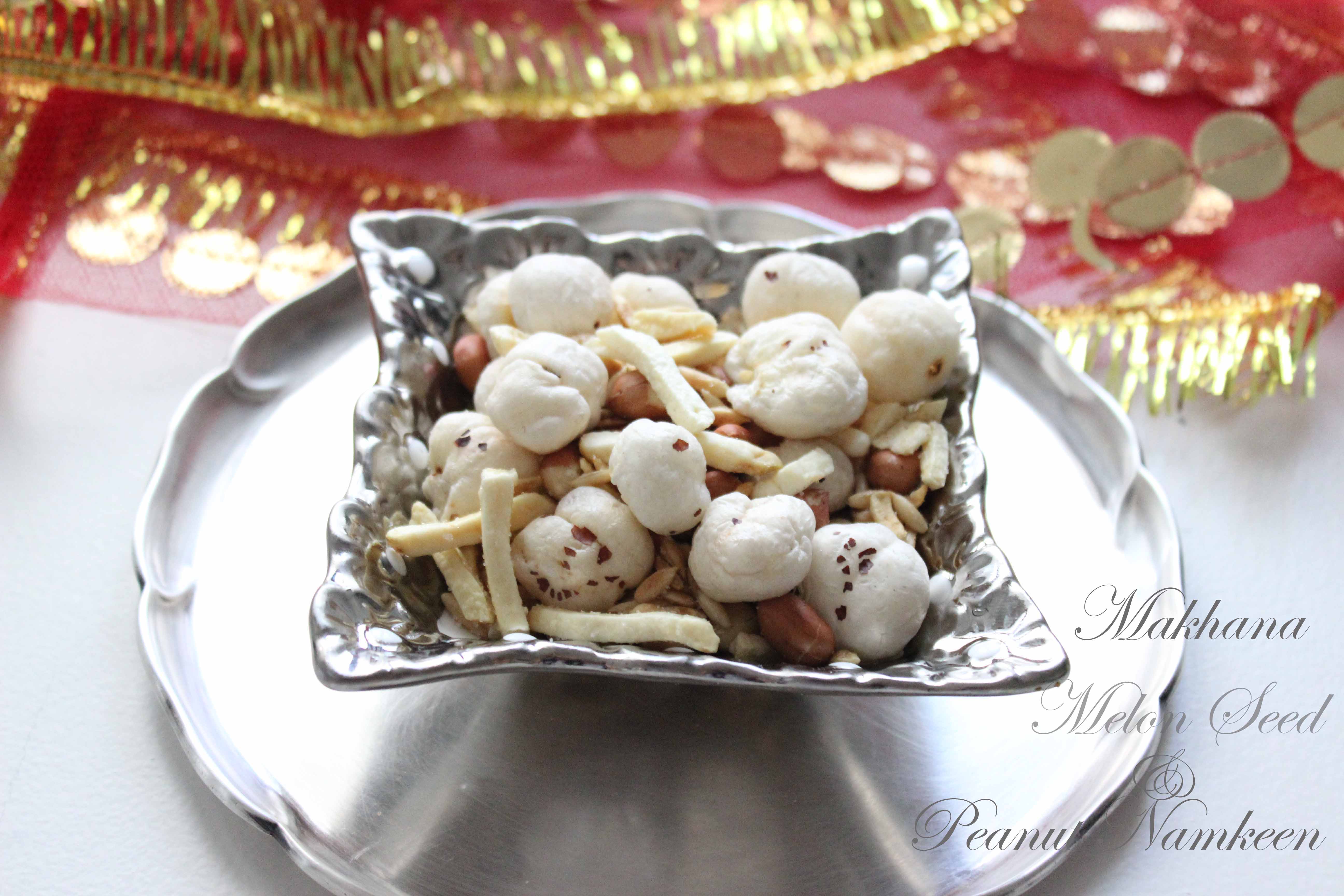
Makhana, Melon Seeds & Peanut Namkeen
Foxnut, Melon Seeds & Peanut Snack
A healthy namkeen is made by gently tossing the makhana, melon seeds, peanuts and potato chips in ghee with just a sprinkling of salt and red chilli powder.

Makhana
Fox Nut, also known as Makhana in Hindi is a flowering plant classified in the water lily family which grows best in locations with hot, dry summers and cold winters. The plant produces starchy white seeds that are edible and are collected in the late summer and early autumn. The seeds may be eaten raw or cooked.
In India, in the northern and western parts of the country, fox nut seeds are often roasted or fried, which causes them to pop like popcorn and are eaten with a sprinkling of oil and spices. Makhana is an auspicious ingredient in offerings to the Goddesses during festivals and is used to show reverence. Makhanas are used to make a porridge/pudding called Kheer of Makhana or ‘Makhana Kheer’ .
Makhana represents an outstanding source of carbohydrates, proteins and minerals. These seeds are low in saturated fats, sodium and cholesterol and have a substantial amount of minerals such as magnesium, potassium and phosphorus. ~ Wikipedia
Melon Seeds
The melon is a cooling and nutritious fruit and found in abundance during the summer time in India. Being low in calories and having a high water content, the melon is a refreshing and healthy food. The melon seed is a grayish white hard shell with a white inner kernel, which is soft and oval in shape. The seeds of the melon are rich in protein, omega-3 fatty acids, vitamins, fats and other nutrients. They have a nutty and sweet taste. They can be eaten raw or roasted.
Peanut
The Peanut or Groundnut is a species in the family Fabaceae, commonly known as the bean, pea or legume family. The peanut is not technically a nut but rather a legume. Peanuts are often referred to as a nut in common English. Peanuts can be eaten raw, used in recipes, made into oils, textile materials, and peanut butter, as well as many other uses.
In the Indian subcontinent, peanuts are known as a light snack by themselves, usually roasted and salted and often sold roasted in pod or boiled with salt. They are also made into little dessert or sweet snack pieces by processing with refined sugar and jaggery. Another use of peanut is as cooking oil.
Peanuts are rich in essential nutrients and are an excellent source of several B vitamins, vitamin E, several dietary minerals, such as manganese, magnesium and phosphorus and dietary fiber. They also contain protein in a higher proportion than in many tree nuts.
Makhana, Melon Seeds & Peanut Namkeen
Foxnut, Melon Seeds & Peanut Snack
Ingredients ~
100 gms makhana
100 gms peeled melon seeds
100 gms shelled peanuts
100 gms dried potato chips
salt, chilli powder to taste
vegetable oil for frying
2 tbsp ghee
Method ~
1. Dry roast the melon seeds and the peanuts individually in a hot wok.
2. Heat the oil and fry the dried potato chips till they double in size.
3. Cut each makhana into two pieces.
4. Add the ghee in the hot wok and roast the makhana pieces. Add the roasted melon seeds, peanuts and potato chips.
5. Sprinkle salt and chilli powder and stir to coat the mixture.
6. Serve hot or cold.
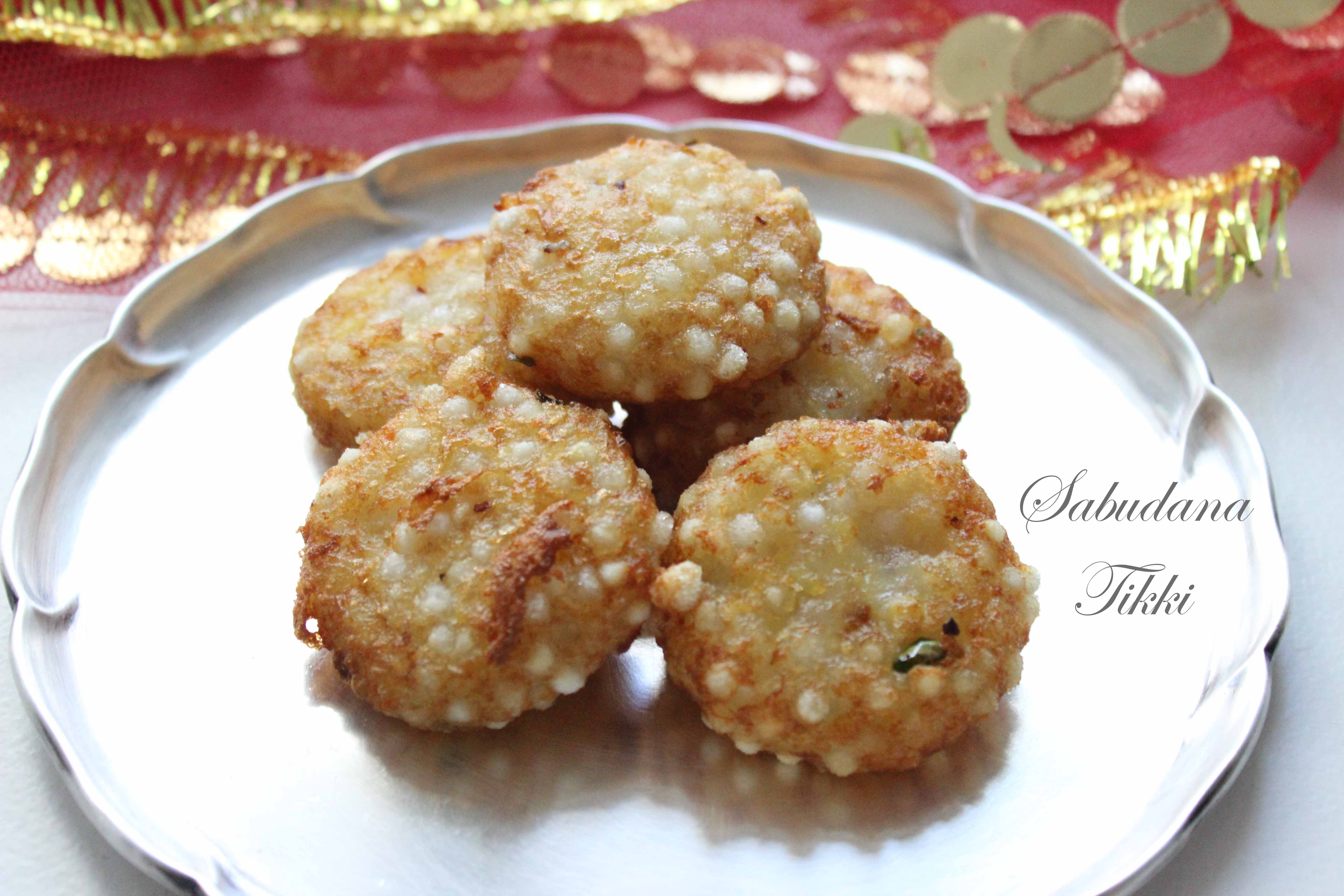
Sabudana Tikki
Sago & Potato Cutlets
Sabudana tikki, is made with boiled mashed potatoes, re-hydrated sago pearls, crushed peanuts, chopped green chillies, which are combined and formed into small cutlets and deep fried till golden. They can be eaten for breakfast or as a snack at tea time. To enhance the taste, it is served with green coriander chutney, imli chutney or good old tomato ketchup.

Tapioca Sago is generally known as Sabudana in Hindi. Sago is a produce, prepared from the milk of Tapioca Root. As making the tapioca sago is long and cumbersome, it is commercially produced and is available in most Indian grocery stores.
Making of tapioca sago ~
The tapioca root, received from the farms is hygienically cleaned in water & after peeling the skin, it is crushed, allowed to pass the milk after retaining all fibre & impurities. The milk is settled in a tank for nearly 3 to 8 hours, thus all residual impurities float to the top of the tank & are drained out of the settled milk. From this settled Milk Cake, globules are made on a very simple indigenous machine. After sizing the globules by filtering through sieves, it is roasted on hot plates or heated in steam, depending upon the desired final product. Sago in globular shape is then dried under direct sunlight on big platforms. ~ Sabuindia.
As Sabudana is mainly starch which contains carbohydrates, it is great for a quick boost of energy, and is often served in India for breaking fasts during religious festivals. It is a very nutritious product as it contains Carbohydrates and appreciable amount of Calcium and Vitamin-C. Sabudana being flavourless, can be used in a number of dishes, either savoury or sweet.


I remember my grandmother and mother making these tikkis or cutlets. Though they were made through the year for a snack, it was during the festival fasting that they were made on a frequent basis. The outer crunch of the deep fried tikki gives way to a soft centre and the crushed peanuts and the heat from the cut green chillies further enhance the taste.
Sabudana are dried globules which need to be re-hydrated with water. This is the tricky part. After following many hit and miss trials on the advice given by friends and family, she feels the best way to re-hydrate them is to spread them out on a flat plate and sprinkle water over them. The sago pearls will absorb the water. This process needs to be repeated till the sabudana pearls/globules are soft to touch and there is no hard part right till the centre. Too much water will make them soggy, so its best to give time between the times the sago pearls are sprinkled till you achieve the softness. As the quality and size of the sago pearls differs, she feels this is the best way.
I boil the potatoes till soft and mash them and adds the sadudana pearls. Salt and red chilli powder/cut green chillies are used to give it taste and the peanuts give it added crunch. While shaping the tikkis, it helps to oil your palms with vegetable oil. This helps prevent the tikki batter from sticking to the palms and makes it easier to roll the tikki into shape.
Sabudana Tikki
Sago & Potato Cutlets
Ingredients ~
200 gms sabudana/sago pearls
1 medium potato
50 gms roasted peanuts
1 small green chilli, optional
1/3 tsp salt
1/4 tsp red chilli powder
vegetable oil for frying
Method ~
1. Re-hydrate the sabudana pearls by placing them on a flat plate and sprinkling water over them occasionally till the pearls feel soft to the touch.
2. Boil the potato. When cool, peel it and either grate it through a fine grater or mash it.
3. Crush the peanuts coarsely and remove the skins that may separate from the peanut.
4. Chop the green chilli if using.
5. Grease your palms with a little vegetable oil and mash all the ingredients together.
6. Season with salt and red chilli powder.
7. Roll the batter into small balls and flatten them to form tikkis/cutlets.
8. Heat vegetable oil in a wok and when hot gently drop the tikkis in and fry till golden in colour.
9. Serve with Imli Chutney during a fast. Otherwise you can serve with Green Coriander and Mint Chutney.
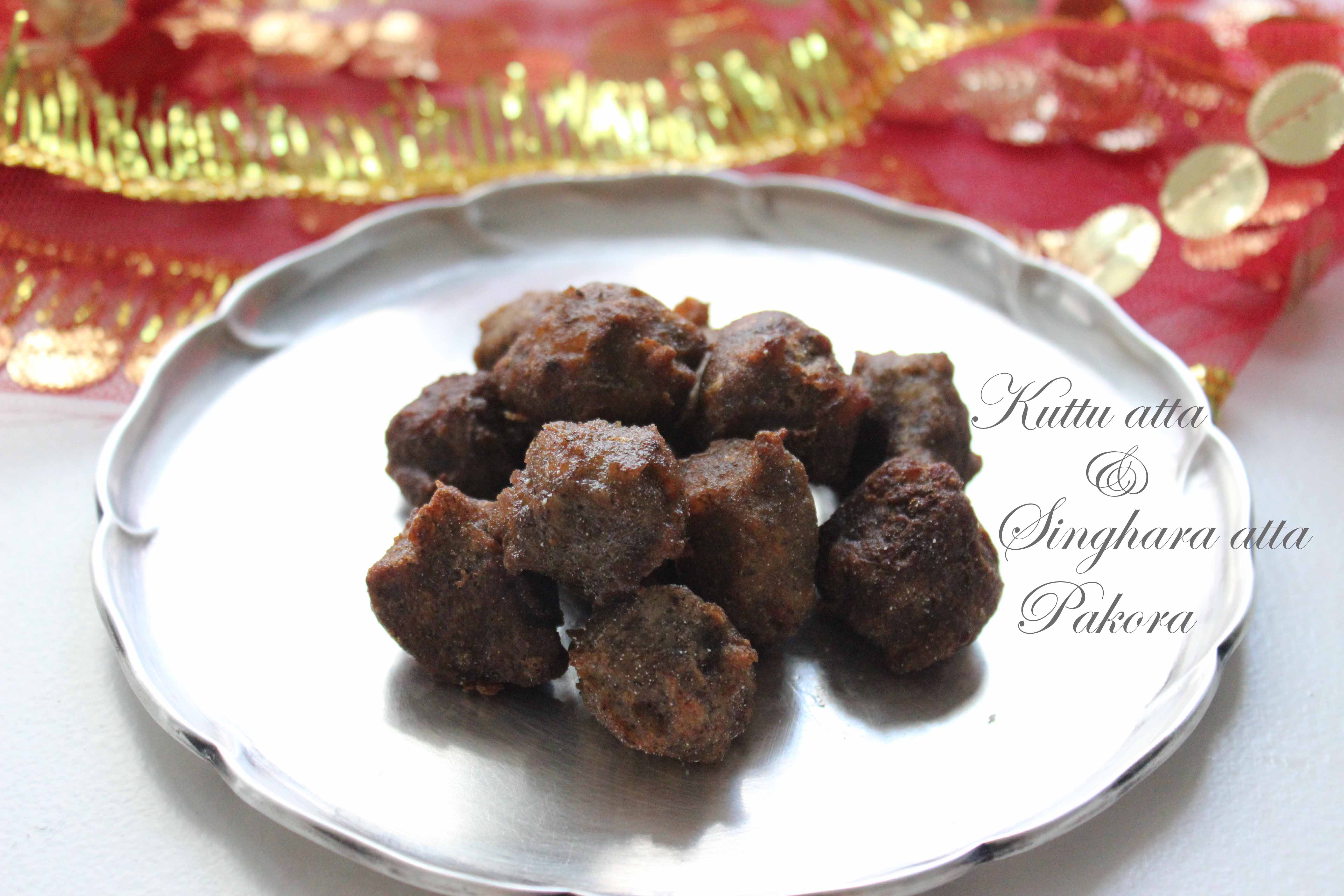
Kuttu & Singhara Atta Pakoras
Buckwheat & Water Chestnut Flour Fritters
Kuttu and Singhara pakoras are fritters made with buckwheat and water chestnut flours. Mashed boiled potatoes are used to bind the flours and give them a soft centre to contrast the outer crispness. Kuttu and Singhara flour do not contain gluten and are low on the glycaemic index. Both flours have high nutritional value and help in releasing slow energy when eaten during religious fasts.

Kuttu or Buckwheat is not a cereal grain but actually a fruit seed, therefore eaten during religious fasting in India. It is also a suitable substitute for people who are sensitive to wheat or other grains that contain protein glutens.
Diets that contain buckwheat have been linked to lowered risk of developing high cholesterol and high blood pressure. Buckwheat is a good source of magnesium which relaxes blood vessels, improving blood flow and nutrient delivery while lowering blood pressure. The nutrients in buckwheat may also contribute to blood sugar control. Eating foods high in insoluble fiber, such as buckwheat, can help women avoid gallstones. It is also good at drawing out retained water and excess fluid from swollen areas of the body.

Singhara or Water Chestnut is a fruit therefore eaten during religious fasting in India. It can be eaten raw, boiled or as flour, after drying and grinding. Singhara is indigenous to India and used in Ayurveda to cure various diseases.
Singhara is rich in proteins, carbohydrates, vitamin B, C, iron, calcium, magnesium, phosphorus, iodine and contains no fat. It is a natural antioxidant, prevents wrinkles and protects from UV rays. It helps to prevent sugar, ulcer, gout and heart diseases and is used for treating diarrhoea, dysentery, thyroid problem, swelling and bronchitis. It contains iodine, manganese and other minerals that help in proper functioning of thyroid.

All through my childhood and even today, these kuttu and singhara pakoras have been my favourite food during the Navratri festival. My mother would only use the buckwheat flour but I learnt to add the water chestnut flour from my husband’s aunt, as it gave the fritters lightness and made them less dense.
The trick to cook them well, is to fry them on medium heat, so they cook through yet don’t burn. As these flours do not have gluten, we add mashed boiled potatoes to bind them. A little bit of water turns the whole mixture into a sticky wet dough, just enough to be able to form soft balls with the fingers of one hand and drop the balls into the hot oil to fry. The Indian way to drop fritters into the hot oil is to wet the palms, make the dough ball with the tips of the fingers and push the dough ball into the oil by pressing it down with the thumb.
Carom seeds have a similar taste to oregano and smell faintly like thyme. Their addition is to give flavour and also to help digest the fried fritters. If you want to avoid the potatoes, you can substitute grated cottage cheese instead.
Kuttu & Singhara Atta Pakora
Buckwheat & Water Chestnut Flour Fritters
Ingredients ~
1 cup kuttu atta/buckwheat flour
1/3 cup singhara atta/water chestnut flour
2 medium potatoes
salt, red chilli powder to taste
¼ tsp ajwain/carom seeds
vegetable oil for frying
Method ~
1. Boil the potatoes, peel and grate them.
2. Mix both the kuttu and the singhara flours.
3. Add the salt, red chilli powder and the ajwain to the flour.
4. With your hand, mix in the grated potatoes. Add just enough water to lighten the mixture and bind it all together.
5. Heat vegetable oil in a wok.
6. Wet your hands and drop small balls of the pakora batter into the hot oil.
7. Reduce the flame to medium and cook the pakoras till crisp on the outside and cooked inside.
8. Can be eaten hot or cold.
Serve with Imli Chutney, Raita, Khatte Aaloo ki Sabji, Khatti Arbi ki Sabji.
Kuttu Paneer Pakora
Buckwheat coated Cottage Cheese Fritters
Any north Indian will tell you that cottage cheese fritters are his favourite, these are universally loved by vegetations in India. Kuttu Paneer Pakora is a variation of paneer pakoras coated with gram flour batter. I found cottage cheese batons or cubes when dipped in buckwheat flour batter, had a thick inconsistent look to them. So, by rolling the cheese in dry flavoured flour, I found the look, texture and taste improved immensely. This is not how traditionally these fritters are coated, but I feel my variation is a great leap forward in improvement.


Paneer or Cottage Cheese is a fresh cheese made by curdling hot milk with the addition of lemon juice, vinegar or yogurt. The whey is separated by hanging the curds in a muslin cloth and the resulting cheese is called paneer.
Paneer is a source of protein for vegetarian people and helps to fulfill their protein need of the body. It has a high level of calcium and phosphorus which helps in building strong bones and teeth. It also has Omega-3 Fatty Acids and Omega-6 Fatty Acids which help in fighting rheumatoid arthritis. The presence of monounsaturated and polyunsaturated fat in paneer helps in lowering the body weight. It also has high level of dietary fibres which help in digestion by improving the metabolism. It has high levels of vitamin B and enhances blood formation, assists in more nutrients absorption by the body and strengthens the liver.
Kuttu and Singhara flour do not contain gluten and are low on the glycaemic index. Thus, they help in releasing slow energy when eaten during religious fasts. Both flours have high nutritional value and so are perfect for breaking fasts. Paneer is a high protein food and provides instant energy.
I soak the cottage cheese batons in salted water to which I add juice of half a lemon. This helps the cheese acquire some sourness and saltiness beyond the taste of the coating. Take the batons out of the water and roll them in flavoured buckwheat/water chestnut flour combination. This needs to be done at the time of frying. Once the cheese is rolled in flour, drop it into hot oil to fry. If the cheese is coated and left for some time before frying, the wetness of the cheese comes through and the fritter will not be as crisp.
Kuttu Paneer Pakora
Buckwheat coated Cottage Cheese Fritters
Ingredients ~
1 cup kuttu flour/atta
1/3 cup singhara flour/atta
250 gms paneer/cottage cheese
½ lemon, juice
salt, red chilli powder,
¼ tsp ajwain/carom seeds to taste
vegetable oil for frying
Method ~
1. Cut the paneer into batons or cubes.
2. Soak the paneer in water and add salt and juice of ½ lemon. This helps in adding the salt/sour flavour to the paneer itself.
3. Mix both the buckwheat and water chestnut flour.
4. Add the salt, red chilli powder and the carom seeds to the flour. Spread on a plate.
5. Heat vegetable oil in a wok, should not be too hot or the fritters will burn.
6. Take the paneer and roll it in the dry flour mixture.
7. Cook in the hot oil till crisp.
8. Can be eaten hot or cold.
Serve with Imli Chutney, Raita, Fruit Chaat.

Indian Raita
Indian Flavoured Yogurt
In most parts of India, yogurt or curd is eaten at every meal. It is either eaten plain or with addition of vegetables and spices like salt, red chilli powder and ground roast cumin. This savoury yogurt is called Raita.
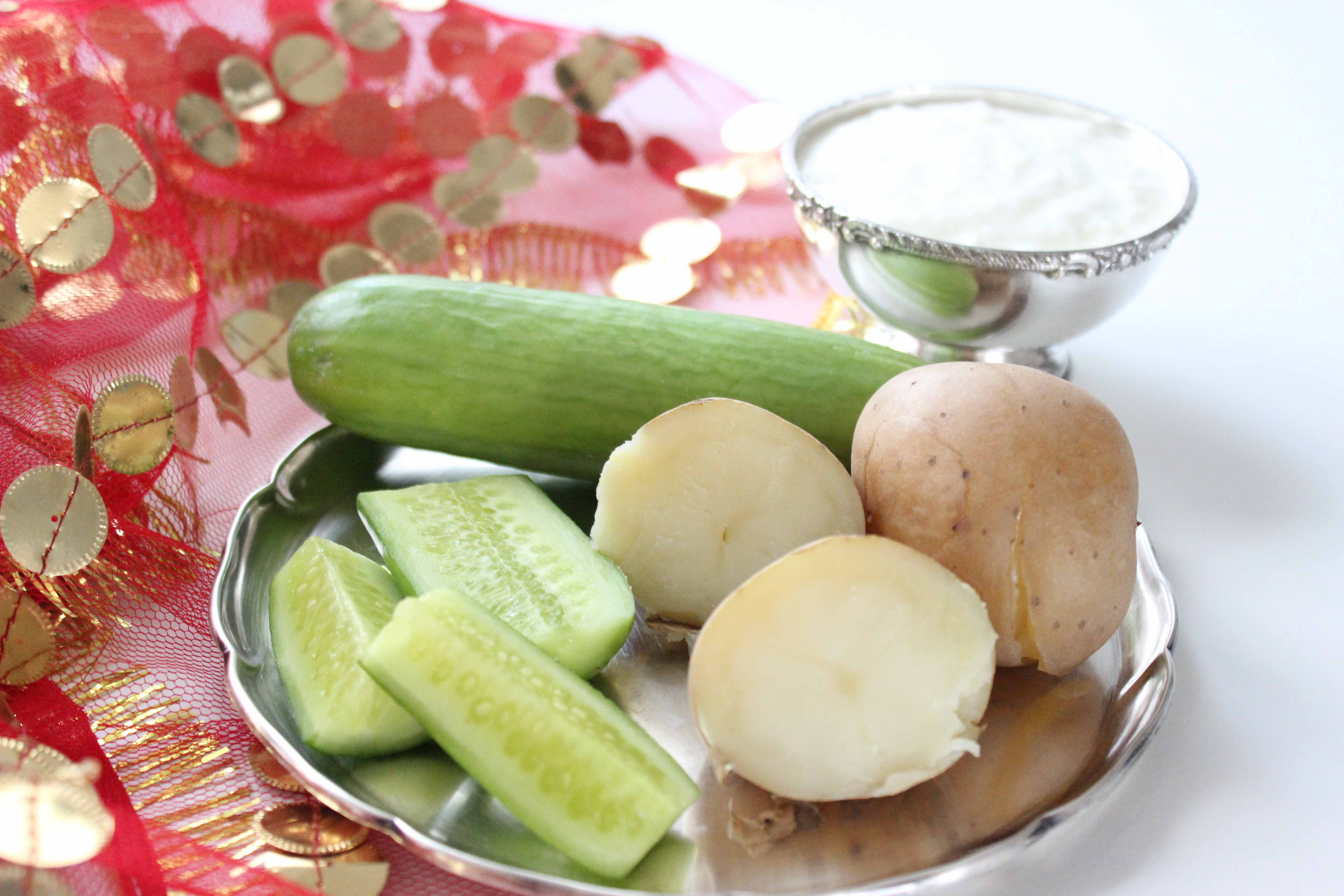

There are many different ways to flavour yogurt in Indian cuisine. You can add vegetables like grated cucumber, chopped tomatoes, onions or boiled potatoes, beetroot, etc. The list is endless. Each family will have their favourite raita recipe or many, depending on the meal or occasion.
In India most families make their own yogurt daily. Yogurt is a cultured milk product that is soured and thickened with the addition of cultures to milk. It has probiotics that help maintain a healthy digestive system and boost the immune system. It is highly nutritious and is an excellent source of protein, calcium and potassium. It provides numerous vitamins and minerals and is relatively low in calories.
Many people who are lactose intolerant can enjoy yogurt. Yogurt contains lower amounts of lactose than milk because the lactose in yogurt is converted to lactic acid by the bacterial cultures. ~ Dairy Council of California
Indian Raita, 3 ways
Indian Flavoured Yogurt
Ingredient ~
250 gms yogurt/curd
1 cucumber
1 boiled potato
salt, red chilli powder, ground roasted cumin to taste
Method ~
1. Peel the cucumber, grate or chop it.
2. Peel the boiled potato and chop it fine.
3. Beat the curd, add the spices and the vegetable of your choice.
4. You can make three different kinds of raita, grated cucumber raita, chopped cucumber raita or chopped boiled potato raita.
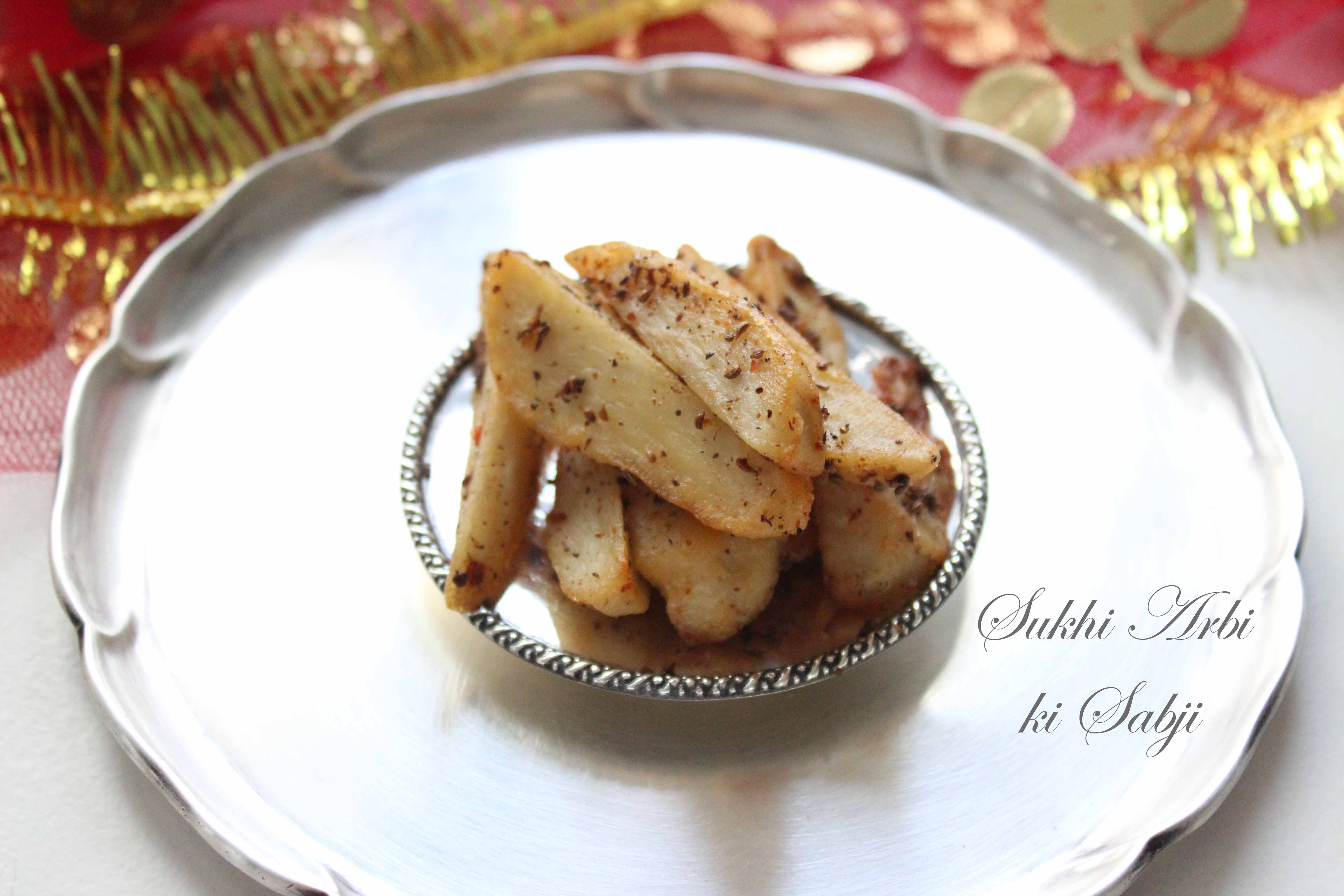
Sukhi Arbi ki Sabji
Sautéed Spicy Taro Root Vegetable
Sukhi Arbi ki Sabji or sautéed spicy taro root vegetable is a perennial favourite of my family. Arbi or taro root is boiled, cut into batons and deep fried. It is then finished off by sautéing with a sprinkling of dry spices like red chilli powder, carom seeds, salt, and dry mango powder. To make it more heart friendly, I mostly omit the frying step and sauté the boiled arbi in the spices with a little oil, but sometimes we get indulgent.


Arbi or Taro Root is thought to be native to Southern India and Southeast Asia. It is a perennial, tropical plant primarily grown as a root vegetable for its edible starchy corm, and as a leaf vegetable.
Arbi is low in fats and the calorie value chiefly comes from complex carbohydrates. Their protein levels can be comparable to that of other tropical food sources like yam, cassava, potato, plantain, etc. The corms are free from gluten. They carry high-quality phyto-nutrition profile comprising of dietary fiber and antioxidants in addition to moderate proportions of minerals and vitamins.It also contains good levels of some of the valuable B-complex group of vitamins.
Further, the corms provide healthy amounts of some of important minerals like zinc, magnesium, copper, iron, and manganese. In addition, the root has very good amounts of potassium. Potassium is an important component of cell and body fluids that help regulate heart rate and blood pressure.
The plant is inedible when raw and considered toxic due to the presence of calcium oxalate. The toxin is minimized by cooking. In this recipe the Arbi is boiled, then fried and finished with a tempering of spices.
For me, arbi is the fancier cousin of the potato, both widely used in cooking in my house. Whereas the potato takes kindly to being added to other vegetables, the arbi needs to be cooked by itself. Maybe we have grown up eating this root vegetable so love it, for I think it is an acquired taste. The taste is a cross between a potato and a yam. Through their childhood I made this dish for my children, omitting all spices except salt, and told them it was fried fish. They only realised the difference much later and will not forgive me to this day for hoodwinking them to eat the vegetable in the name of fish.
Care must be taken not to over boil it as it turns slimy. Once boiled and peeled, it should be left to cool before cutting it and frying it. The slimy feel dries out and makes it easier to cook.
Once boiled and fried, take a little oil, temper the carom seeds to release their fragrance, and add the fried arbi. Toss it to coat them in the tempered carom seeds, lower the flame and sprinkle the dried spices. Toss again to coat evenly.
Carom seeds have a similar taste to oregano and smell faintly like thyme. Their addition is to give flavour and also to help digest the taro root.
The sautéed spicy arbi tastes good by itself, though more often, it forms a part of the Indian meal which compromises of a vegetable stew or lentil, a dry vegetable, yogurt, salad, chutney and roti or rice.
Arbi is one of the finest source dietary fibres. Together with slow digesting complex carbohydrates, moderate amounts of fibre in the food help gradual rise in blood sugar levels and for this reason it is a good vegetable to have during fasting. This is why arbi is generally cooked during the Navratri festival to break the fast.
Sukhi Arbi ki Sabji
Sautéed Spicy Taro Root Vegetable
Ingredients ~
5 medium arbi/taro root
1/4 tsp ajwain/ carom seeds
1/2 tsp red chilli powder
1/2 tsp salt
1 tsp ground dried amchur/mango powder
vegetable oil for frying
Method ~
1. Boil the arbi till tender.
2. Peel and leave to cool.
3. Once cool, cut into batons or into 4 pieces length wise.
4. Heat the oil in a wok. Fry the arbi till golden and crisp.
5. Empty the oil from the wok, leaving about a tablespoon.
6. In the hot oil temper the ajwain or carom seeds.
7. Take the cut arbi and add them to the pan. Cook till coated in the oil.
8. Lower the flame. Add the red chilli powder, salt and the amchur powder.
9. Cook till coated in the spices and crisp.
Serve hot with Kuttu Roti, Kuttu Puri, Khatte Aaloo ki Sabji, Khatti Arbi ki Sabji, Samak ke Chawal, Sabudana Khichri during the Navratri fast.
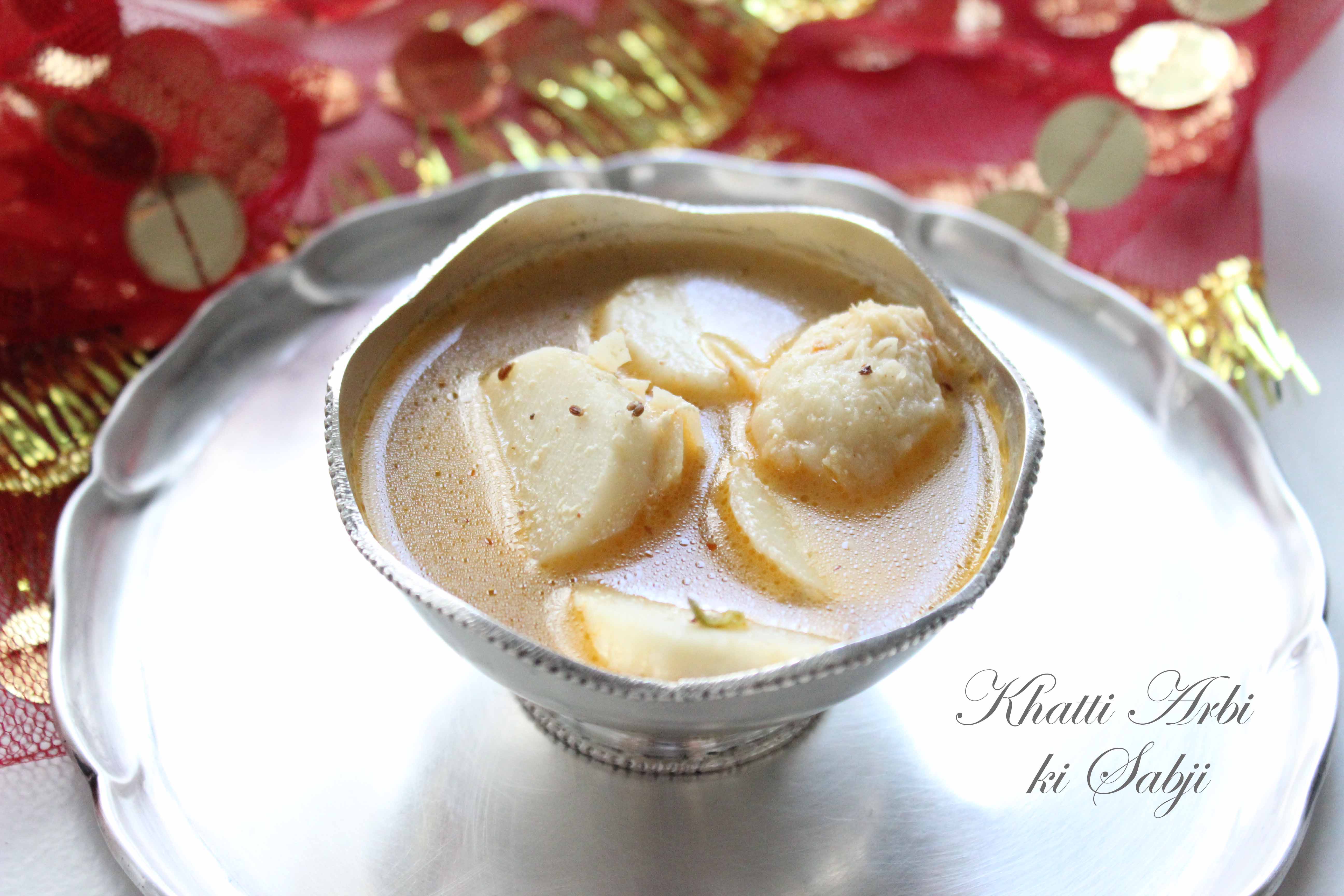
Khatti Arbi ki Sabji
Sour Taro Root Stew
Khatti arbi ki sabji or a taro root stew which has been soured by dry mango powder and yogurt, is a simple recipe which has its origins in the kitchens of my grandparents. Its simple enough to make, boiled arbi, sautéed in a bit of yogurt and spices and made into a stew by adding water.

Khatti Arbi ki Sabji
Sour Taro Root Stew
Ingredients ~
5 medium arbi
2 tbsp curd/yogurt
1/4 tsp ajwain seeds
1/2 tsp red chilli powder
1/2 tsp salt
1 tsp ground dried mango powder/amchur
1 tbsp ghee
Method ~
1. Boil the arbi.
2. Peel and cut the boiled arbi into rounds.
3. Heat a pan on the stove. Add a tablespoon of ghee.
4. In the hot ghee temper the ajwain seeds and red chilli powder.
5. Beat the curd and add it to the spices in the pan. Cook till thick.
6. Take the cut arbi and add them to the pan. Cook till coated in the spice mixture.
7. Add drinking water to cover the arbi mixture and bring to a boil. Once it comes to a rolling boil, reduce the heat to simmer and partially cover the pan with a lid.
8. Add the amchur powder to sour the gravy. Adjust the seasoning to make the gravy a blend of salty, chilli and sour.
9. Once the gravy is thick remove from the stove. Serve with Kuttu Roti, Kuttu Puri.
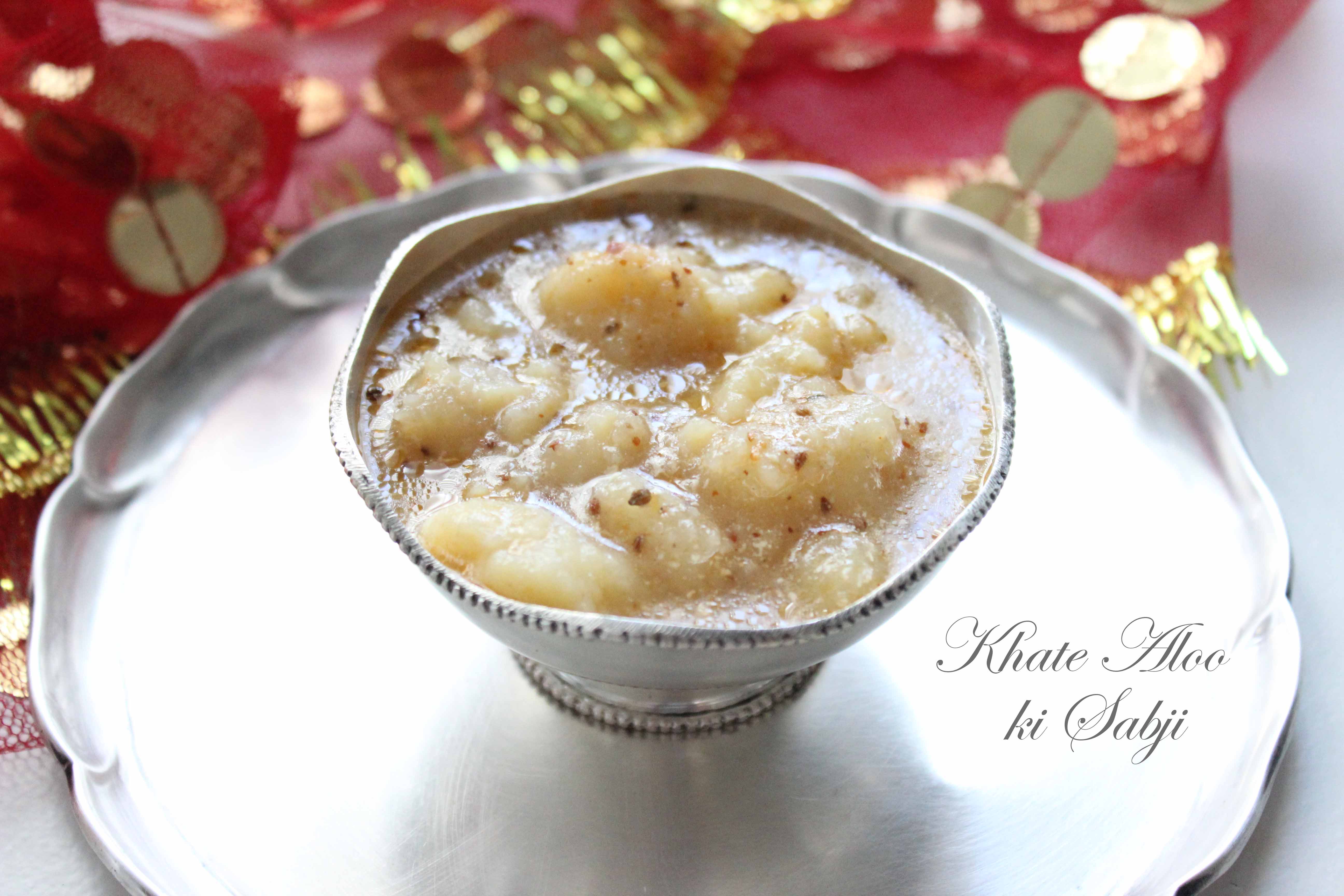
Khatte Aloo ki Sabji
Sour Potato Stew
Khatte aloo ki sabji or a potato stew which has been soured by dry mango powder, is a simple recipe which has its origins in the kitchens of my grandparents. Its simple enough to make, boiled potatoes, sautéed in a bit of yogurt and spices and made into a stew by adding water.

Aloo or potato is one of the most important staple crops in India and is used widely all over India, in every regional cuisine. It can be eaten boiled, fried, sautéed, in gravys and is added in most vegetables to add bulk.
This nutrient-dense tuber is packed with a variety of vitamins, minerals and phytochemicals that ward off disease and benefit human health.
Many studies have suggested that increasing consumption of plant foods like potatoes decreases the risk of obesity and overall mortality, diabetes, heart disease and promotes a healthy complexion and hair, increased energy, overall lower weight.
This simple stew, which contains squashed boiled potatoes, tempered in a bit of clarified butter or ghee, with carom or ajwain seeds, red chilli powder, salt and dried mango powder, was made on an everyday basis in Shivani’s grandparents house. The house contained a large joint family of her grandfather, his brother, their children and the numerous grandchildren. Her grandmothers were very traditional. Invariably they were on some religious fast or the other every other day of the week.
Potatoes being a cheap vegetable were used in most meals to feed such a large family. Even though, potatoes were made so often, if you asked anybody what their favourite vegetable was, they would still say potato. According to her grandmothers, the tomato was a foreign vegetable, it was not native to India, and as such they would not incorporate that in their recipes. They used yogurt and dried mango pieces or in the powder form to sour their dishes.
My brother to date will eat mainly potatoes in all his meals and this specific stew is an all-time favourite of his. Similarly, my son has a liking for this stew and would often request in be made through his childhood.
Potatoes also contain a compound known as alpha-lipoic acid, which helps the body to convert glucose into energy. Thus, it is a good vegetable to eat during fasting, hence its inclusion in most meals during religious fasts in India.
Khatte Aloo ki Sabji
Sour Potato Stew
Ingredients ~
3 medium potatoes
2 tbsp curd/yogurt
1/4 tsp ajwain/carom seeds
1/2 tsp red chilli powder
1/2 tsp salt
1 tsp ground amchur/dried mango powder
1 tbsp ghee/clarified butter
Method ~
1. Boil the potatoes.
2. Peel and roughly squash the boiled potatoes.
3. Heat a pan on the stove. Add a tablespoon of ghee.
4. In the hot ghee temper the ajwain seeds and red chilli powder, taking care not to let them burn.
5. Beat the curd and add it to the spices in the pan. Cook till the ghee seperates.
6. Take the crushed potatoes and add them to the pan. Cook till coated in the spice mixture.
7. Add the amchur powder to sour the gravy.
8. Add drinking water to cover the potato mixture and bring to a boil. Once it comes to a rolling boil, reduce the heat to simmer and partially cover the pan with a lid.
9. Adjust the seasoning to make the gravy a blend of salty, chilli and sour.
10. Once the gravy is thick remove from the stove.
Serve with Kuttu Roti, Kuttu Puri, Kuttu & Singhara Atta Pakora, Kuttu Paneer Pakora, Samak ke Chawal, Sabudana Khichri during the Navratri fast.
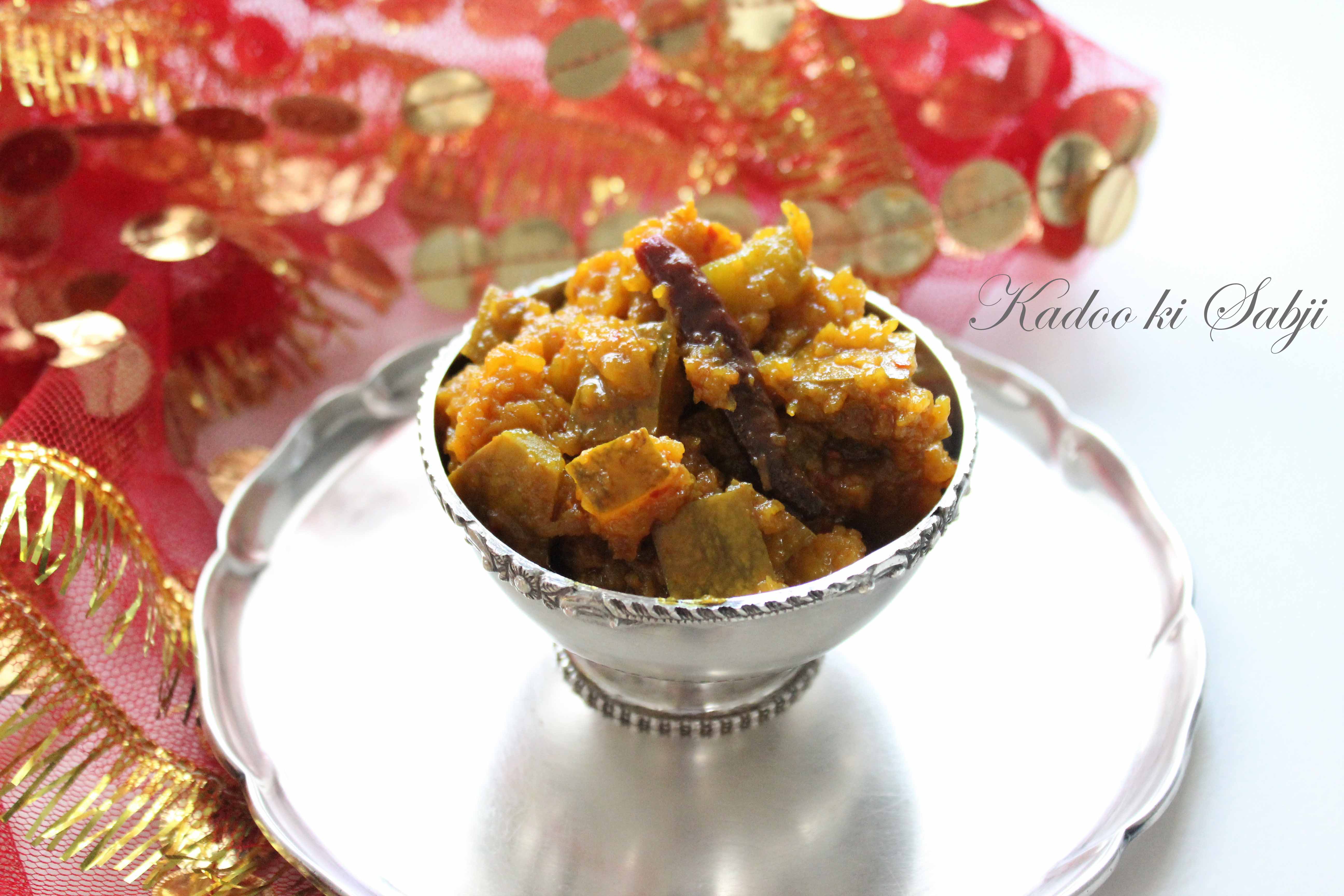
Kadoo ki Sabji
Spicy Pumpkin Vegetable
Kadoo ki sabji is a spicy pumpkin vegetable made across north India. Even though the pumpkin is such a humble vegetable, it absorbs the taste of the spices well and somehow this recipe is elevated to party level menu.
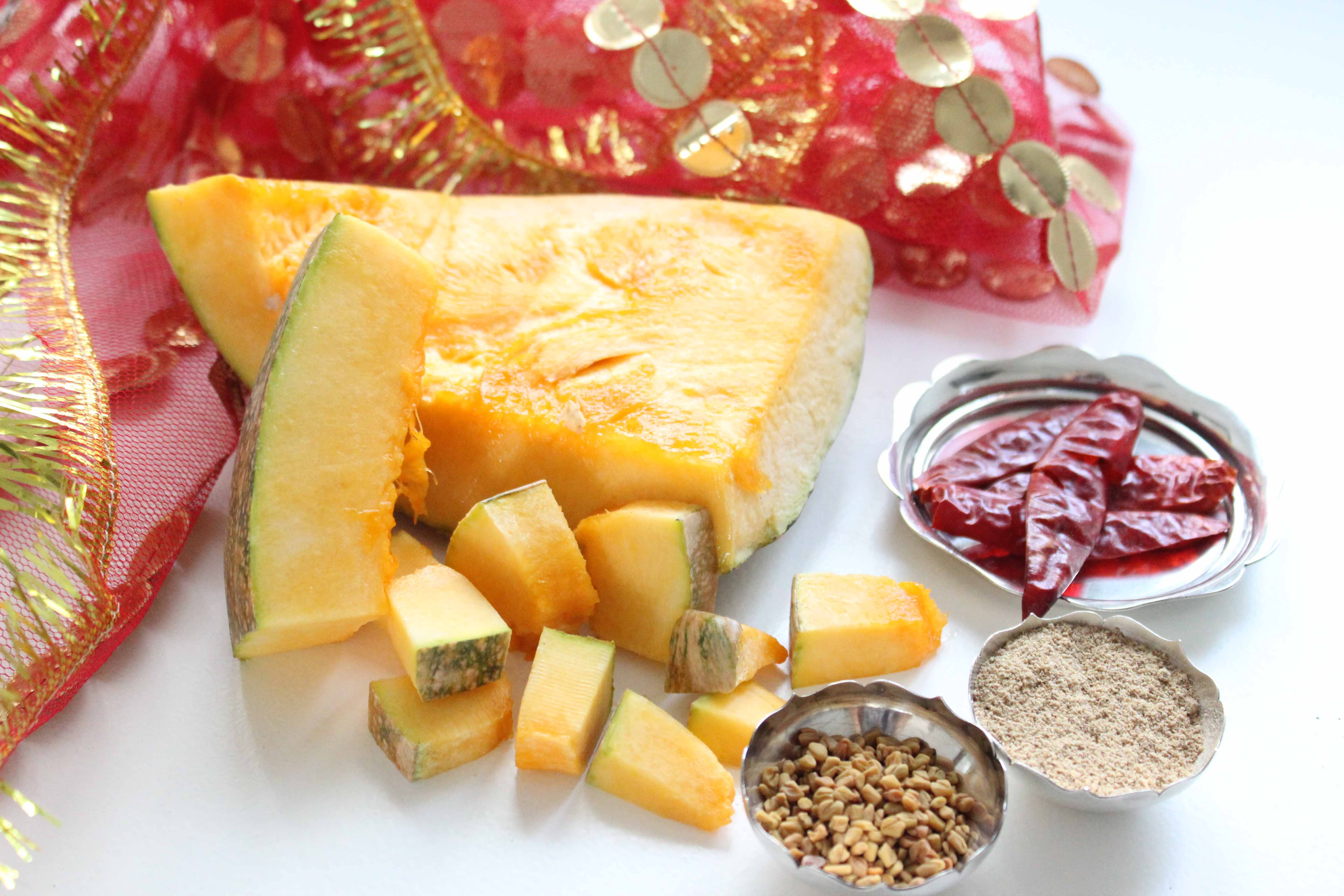
Kadoo or Pumpkin is a cultivar of the squash plant that is round, with smooth, slightly ribbed skin and deep yellow to orange coloration. The thick shell contains the seeds and pulp. It is one of the most popular field crops cultivated around the world for its fruit and seeds.
Kadoo or pumpkin is incredibly rich in vital antioxidants, and vitamins. It is one of the best-known sources of beta-carotene, a powerful antioxidant known to give orange vegetables and fruits their vibrant colour and which is converted to vitamin A in the body. Consuming foods rich in beta-carotene may reduce the risk of developing certain types of cancer, offer protection against asthma and heart disease and delay aging and body degeneration.
Pumpkins are very versatile in their uses for cooking. Most parts of the pumpkin are edible, including the fleshy shell, the seeds, the leaves, and even the flowers. ~ Wikipedia
This recipe of the kaddoo ki sabji has memories from my childhood. On Sunday mornings, the family would visit the local eatery where hot fried pooris were served with a spicy potato stew and this delicious pumpkin, cooked with a number of spices, giving it a sweet, spicy and tart flavour.
It is still cooked the same way even today in my house. Depending on the variety of the pumpkin, the hard skin is either left on or removed. The large ripe yellow/orange pumpkin has a hard skin, so it is removed, and the skin of the smaller green pumpkin being soft is left on while cooking. The skin though helps to keep the pumpkin pieces whole and its removal sort of lets the pumpkin mush a bit. I like it to be firm, so leave the skin on if possible.
The simple tempering with the asafoetida, chillies and fenugreek seeds gives it a beautiful fragrance, while the turmeric adds a glorious golden colour. The sugar and dried mango powder impart a sweet and sour flavour to the vegetable.
Kadoo ki Sabji
Spicy Pumpkin Vegetable
Ingredients ~
250 gms kadoo/pumpkin
1/4 tsp methi/fenugreek seeds
¼ tsp turmeric powder
2 dried red chilli
1/2 tsp salt
1/2 tsp sugar
1/2 tsp amchur powder/dried mango powder
A pinch of hing/asafoetida
1 tbsp oil
Method ~
1. Cut the kadoo into cubes.
2. In a wok heat the oil. Temper the methi seeds and the dried red chilli till they sputter.
3. Add the kadoo and stir to mix. Sprinkle the salt, turmeric powder and cover to cook.
4. Once the kadoo is soft and almost cooked through, add the sugar and the amchur powder.
5. Once cooked, taste to adjust the seasoning. The taste should be a balance of sweet, sour and chilli.
6. Serve hot with Kuttu & Singhara Roti, Samak ke Chaval, Sabudana Khichri.

Singhare ki Sabji
Sautéed Water-chestnut Vegetable
Singhara or Water Chestnut is a fruit therefore eaten during religious fasting in India. It can be eaten raw, boiled or as flour, after drying and grinding.
Singhara is indigenous to India and used in Ayurveda to cure various diseases.

Singhara or Water Chestnut, is rich in proteins, carbohydrates, vitamin B, C, iron, calcium, magnesium, phosphorus, iodine and contains no fat. It is a natural antioxidant, prevents wrinkles and protects from UV rays. It helps to prevent sugar,ulcer, gout and heart diseases and is used for treating diarrhoea, dysentery, thyroid problem, swelling and bronchitis. It contains iodine, manganese and other minerals that help in proper functioning of thyroid.
Singhare ki Sabji
Sautéed Water-chestnut Vegetable
Ingredients ~
500 gms raw singhara/water chestnut
1 tbsp oil
1/4 tsp jeera/cumin
1/3 tsp salt, or to taste
Method ~
1. Shell the singhara/water chestnut.
2. Cut the singhara into two pieces each.
3. In a wok, heat the oil, add the jeera and cook till it sputters.
4. Add the singhara and stir. Sprinkle the salt and stir once again.
5. Add two tablespoons of water and cover the wok with a lid. Cook on low heat.
6. Once the water has evaporated and the singhara is cooked through, yet has a crunch, remove from fire.
7. Serve hot or cold with Kuttu & Singhara Atta Roti, Samak ke Chaval, Sabudana Khichri.
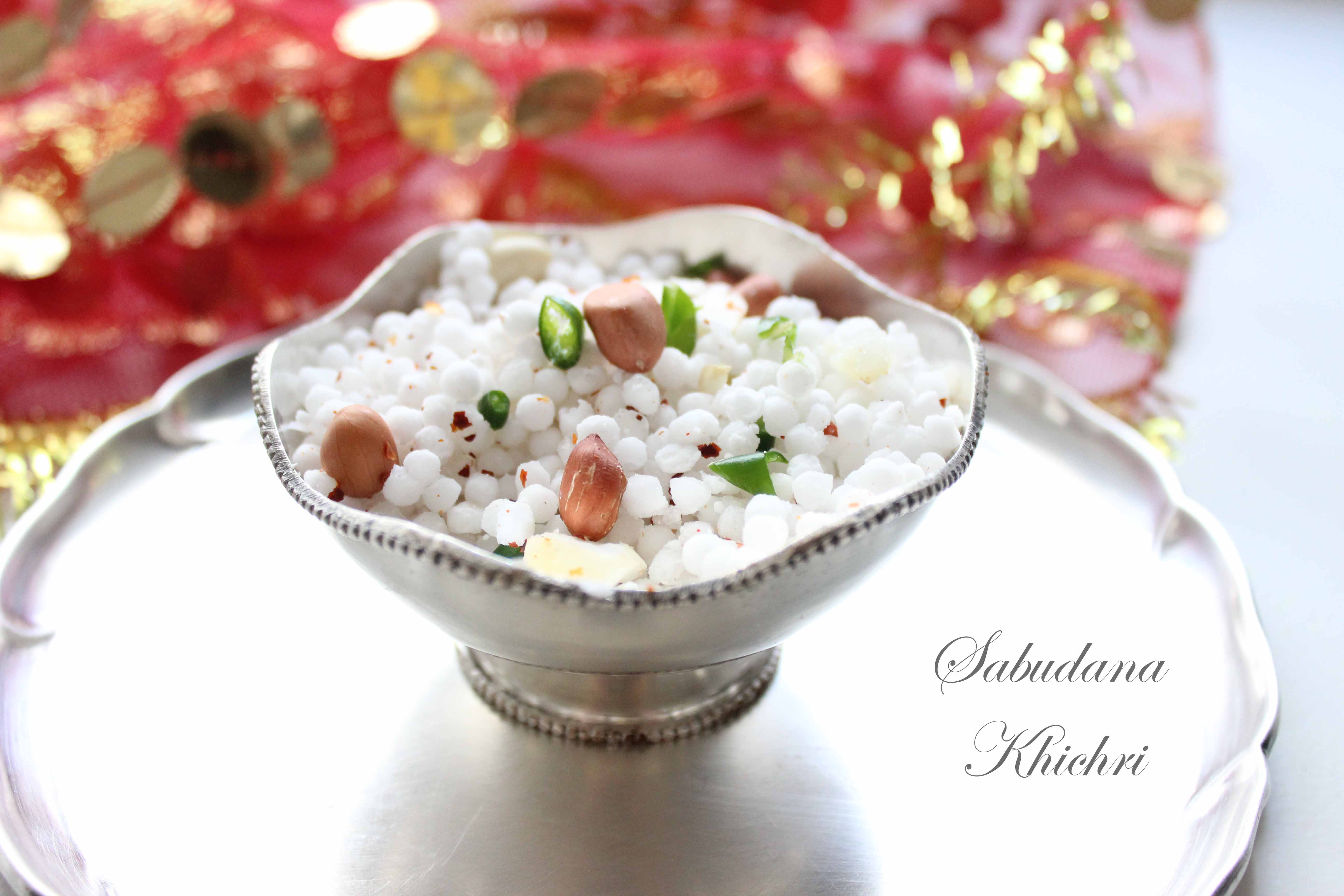
Sabudana Khichri
Sago Khichri
Sabudana or sago pearls are rehydrated and sauted with cubed boiled potatoes, peanuts and green chillies to make sabudana khichri.


As Sabudana is mainly starch which contains carbohydrates, it is great for a quick boost of energy, and is often served in India for breaking fasts during religious festivals. Sabudana can be cooked in either savoury or sweet dishes.
Sabudana are dried globules which need to be re-hydrated. This is the tricky part. The best way to re-hydrate them is to spread them out on a flat plate and sprinkle water over them. They will absorb the water. This process needs to be repeated till the sabudana pearls/globules are soft to touch.
Peanuts used in the making of Sabudana Khichri are necessary as they keep the sabudana pearls from getting sticky and clumping up during the cooking. They also provide the crunch to the soft sabudana pearls. The potatoes need to be crisped before adding the rest of the ingredients, this helps them retain their texture.
Sabudana Khichri
Sago Khichri
Ingredients ~
200 gms sabudana/sago pearls
1 medium potato
50 gms roasted peanuts
1 small green chilli, optional
1/3 tsp salt
1/4 tsp red chilli powder
Method ~
1. Re-hydrate the sabudana pearls by placing them on a flat plate and sprinkling water over them occasionally till the pearls feel soft to the touch.
2. Boil the potato. When cool, peel it and cut into small cubes.
3. Crush the peanuts coarsely and remove the skins that may separate from the peanut.
4. Chop the green chilli if using.
5. Heat vegetable oil in a wok and when saute the potatoes till crisp.
6. Add the peanuts and stir.
7. Gently mix in the sabudana pearls. Add the salt, red chilli powder and cook over slow fire till the the sadudana pearls turn translucent and are heated through.
9. Serve with Imli Chutney,Fruit Chaat, Raita, Khatte Aaloo ki Sabji, Khatti Arbi ki Sabji.

Samak ke Chawal
Samak Rice or Echinochloa colona is a type of wild grass originating from tropical Asia. It is the wild ancestor of the cultivated cereal crop sawa millet. The grass occurs throughout tropical Asia and Africa in fields and along roadsides. In India seeds of this grass are used to prepare a food dish called khichadi consumed during festival fasting days of Navratri. ~ Wikipedia


In the Navratri diet Samak Chawal is a good replacement for rice eaters as it is not a cereal but a fruit. In fact, it can be eaten in every religious fast. It provides the nourishment and energy similar to rice.
Samak ke Chawal
Ingredients ~
1 cup samak chawal/rice
1 potato, boiled
1 green chilli
salt to taste
2 cups water
Method ~
1. Wash the samak chawal till the water is clear.
2. Chop the boiled potato into small cubes.
3. Cut the green chilli, finely.
4. In a pressure cooker, add 1 tablespoon oil. Saute the potatoes and the green chilli or alternatively use a heavy bottom pan with a lid.
5. Add the samak chawal and stir through.
6. Add two cups water and salt to taste.
7. Shut the pressure cooker lid and give one whistle. Remove from stove and let sit till the steam escapes.
8. Open the lid and gently fluff the rice with a fork.
~ If using a pan, add double the amount of water to the rice. When the water is absorbed, test a few grains to see if cooked through. Leave covered. Before eating, fluff with a fork.
Serve hot with Khatte Aaloo ki Sabji, Khatti Arbi ki Sabji, Raita, Imli Chutney and Fruit Chaat.
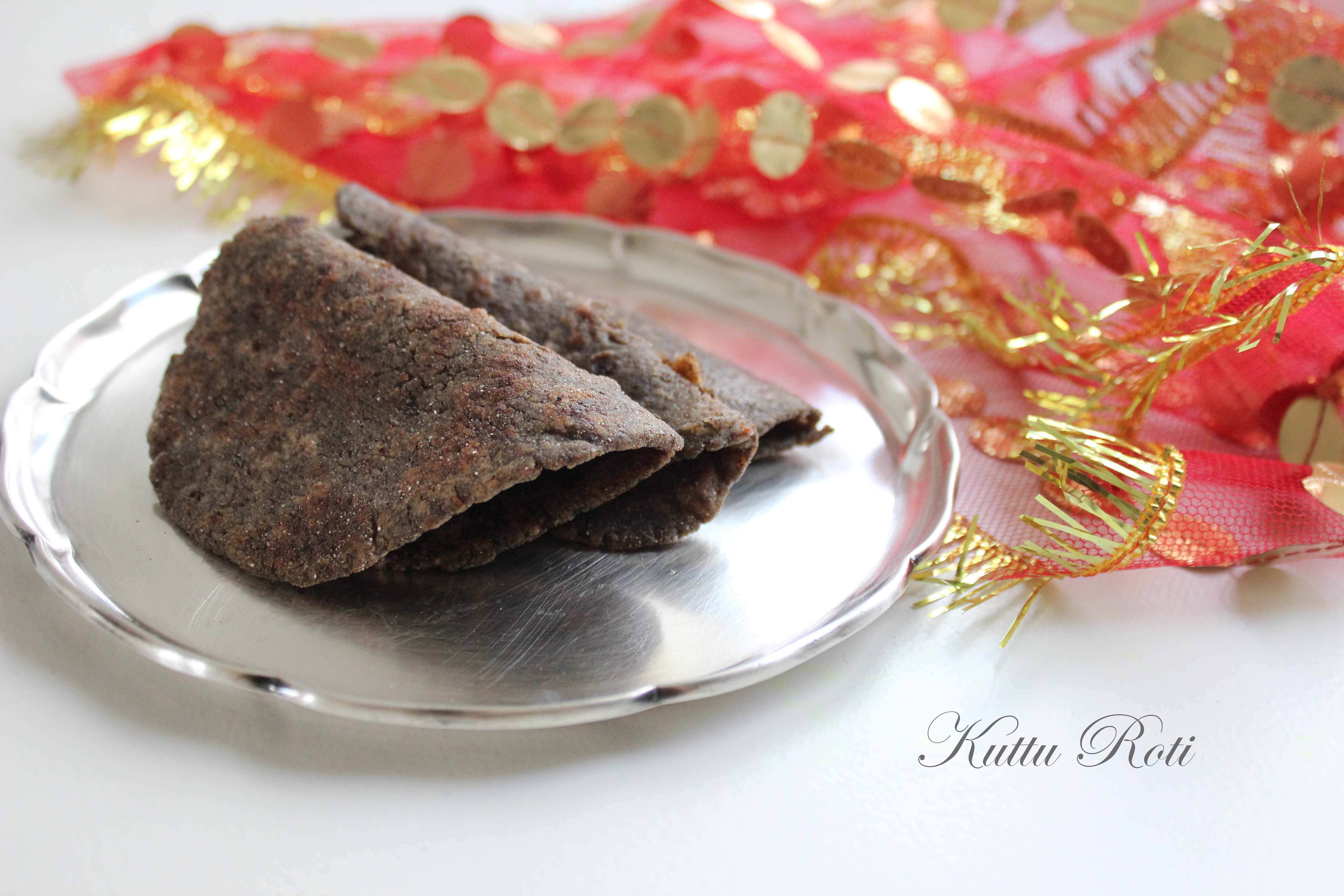
Kuttu & Singhara Atta Roti
Buckwheat & Water Chestnut Flour Flat Bread
Kuttu and Singhara flour do not contain gluten and are low on the glycaemic index. Thus, they help in releasing slow energy when eaten during religious fasts. Both flours have high nutritional value and so are perfect for breaking fasts.


Kuttu or Buckwheat is not a cereal grain but actually a fruit seed, therefore eaten during religious fasting in India. It is also a suitable substitute for people who are sensitive to wheat or other grains that contain protein glutens.
Singhara or Water Chestnut is a fruit therefore eaten during religious fasting in India. It can be eaten raw, boiled or as flour, after drying and grinding. Singhara is indigenous to India and used in Ayurveda to cure various diseases.

Kuttu & Singhara Atta Roti
Buckwheat & Water-chestnut Flour Flat Bread
Ingredients ~
1 cup kuttu atta/flour
1/3 cup singhara atta/flour
2 medium potatoes
salt, red chilli powder to taste
water for kneading
oil for cooking
Method ~
1. Boil the potatoes, peel and grate them.
2. Mix both the kuttu and the singhara flour
3. Add the salt and the red chilli powder.
4. With your hand, mix in the grated potatoes. Add just enough water to bind the flour into a dough.
5. Make small balls of the dough and roll out into round rotis or flat breads.
6. Heat a tava or a flat non-stick pan. Place the roti on it and cook on both sides. Repeat the process, this time brushing a little oil on both sides. Cook till crisp.
7. Can be eaten hot or cold.
Serve with Imli Chutney, Raita, Fruit Chaat, Khatte Aaloo ki Sabji, Khatti Arbi ki Sabji, Sukhi Arbi Ki Sabji, Kadoo ki Sabji, Singhare ki Sabji during the Navratri fast.
~ The rolled rotis can be deep fried in hot oil to make Kuttu & Singhara Atta pooris or a puffed Indian bread.

Sabudana Kheer
Sago Milk Pudding
Sabudana Kheer is a nutritious pudding made with milk and sugar or jaggery. The milk is boiled till half in volumn. Then sugar and the sabudana pearls are added to the milk and cooked till the consistency is thick. The pearls absorb most of the liquid, so care should be taken not to thicken the pudding too much on the stove.


As Sabudana is mainly starch which contains carbohydrates, it is great for a quick boost of energy, and is often served in India for breaking fasts during religious festivals. Sabudana can be cooked in either savoury or sweet dishes.
Sabudana are dried globules which need to be re-hydrated. This is the tricky part. The best way to re-hydrate them is to spread them out on a flat plate and sprinkle water over them. They will absorb the water. This process needs to be repeated till the sabudana pearls/globules are soft to touch.
Sabudana Kheer
Sago Milk Pudding
Ingredients ~
½ cup sabudana/sago pearls
2 cups milk
3 tbsp sugar
2 green cardamoms, powder
kesar/ saffron strands
Method ~
1. Re-hydrate the sabudana pearls by placing them on a flat plate and sprinkling water over them occasionally till the pearls feel soft to the touch.
2. In a heavy bottom pan, mix the milk and the sabudana pearls.
3. Add the sugar and cook on medium flame stirring so that the sabudana does not stick to the bottom.
4. Once the milk is thickened and the sabudana pearls are translucent, take off the fire and add the cardamom powder.
5. Serve hot or cold topped with saffron strands.

Makhane ki Kheer
Foxnut Milk Pudding
In India, in the northern and western parts of the country, Euryale ferox seeds are often roasted or fried, which causes them to pop like popcorn and are eaten with a sprinkling of oil and spices. Makhana is an auspicious ingredient in offerings to the Goddesses during festivals and is used to show reverence. Makhanas are used to make a porridge/pudding called Kheer of Makhana or ‘Makhana Kheer’ . ~ Wikipedia
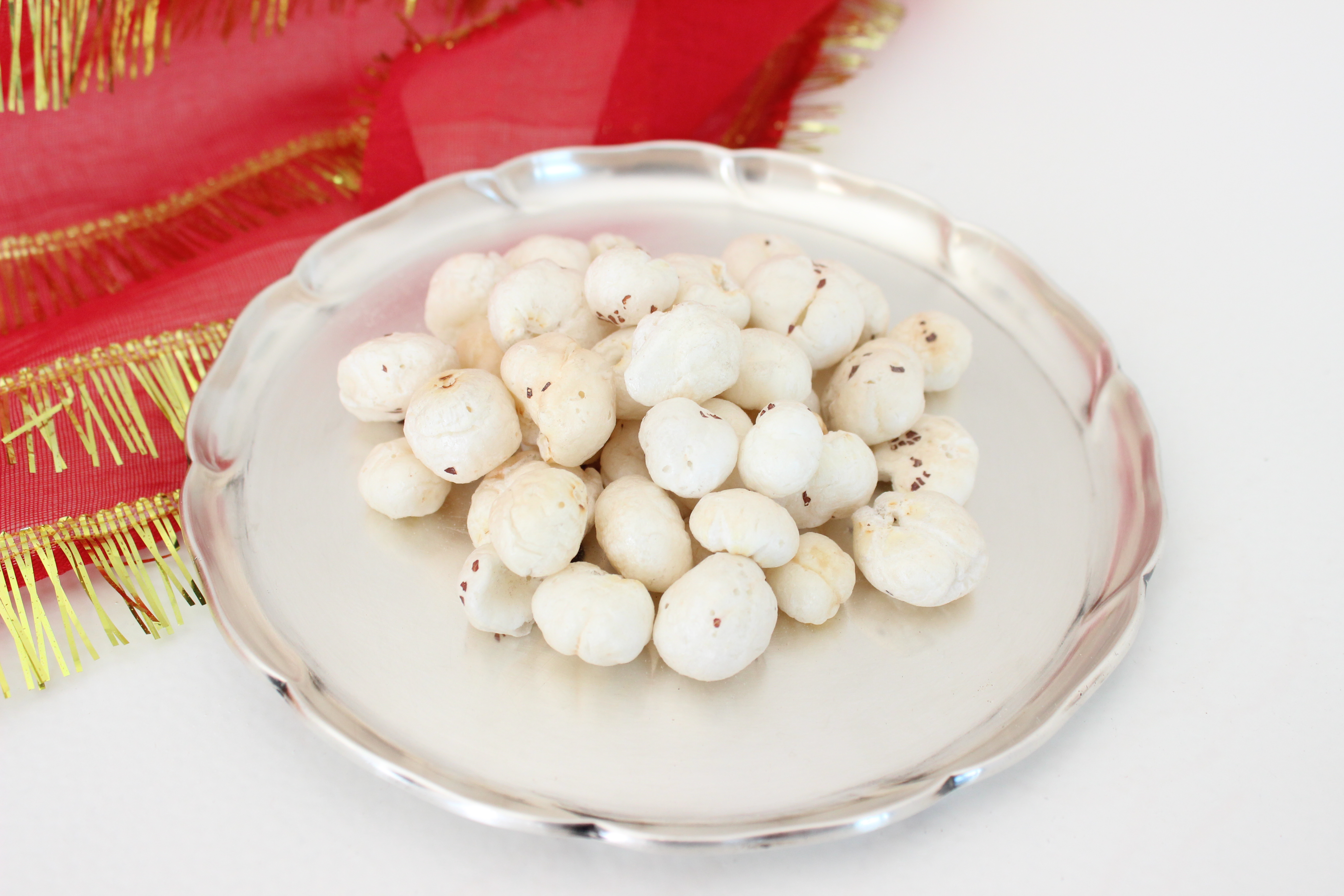

Euryale ferox or Fox Nut, also known as Makhana in Hindi is a flowering plant classified in the water lily family which grows best in locations with hot, dry summers and cold winters. The plant produces starchy white seeds that are edible and are collected in the late summer and early autumn. The seeds may be eaten raw or cooked.
Makhana represents an outstanding source of carbohydrates, proteins and minerals. These seeds are low in saturated fats, sodium and cholesterol and have a substantial amount of minerals such as magnesium, potassium and phosphorus.
Makhane ki Kheer
Foxnut Milk Pudding
Ingredients ~
100 gms makhana/foxnut
2 cups milk
3 tbsp sugar
2 green cardamoms, powder
kesar/ saffron strands
1 tbsp ghee/clarified butter
Method ~
1. Cut the makhanas into quarters.
2. In a heavy bottom pan, sauté the makhanas in the ghee.
3. Add the milk, sugar and cook on medium flame stirring occasionally.
4. Once the milk is thickened and the makhana is soft, take off the fire and add the cardamom powder.
5. Serve hot or cold topped with saffron strands.

